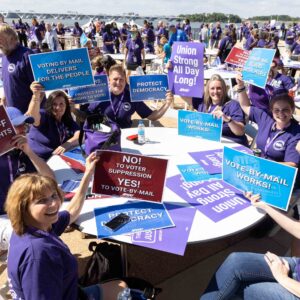March 6, 2015
Marking 50 Years Since Selma

March 7 commemorates the 50th anniversary of the march for civil rights from Selma to Montgomery, AL, which was cut short by police brutality. The march galvanized the burgeoning movement for voting rights and was a catalyst for passage of the Voting Rights Act of 1965.
The historic chain of events was sparked by an incident that took place on Feb. 18, 1965. Approximately 500 people left Zion United Methodist Church in Marion, AL, and attempted to walk to the Perry County Jail, about a half a block away, where a Southern Christian Leadership Conference field worker was being held.
A line of local police and Alabama State Troopers interfered, street lights were turned off, and the marchers were beaten. Jimmie Lee Jackson, 26, along with his mother and grandfather, ran into a café seeking a safe haven. They were chased by state troopers.
When troopers attacked the family, Jackson tried to protect his mother and was shot twice in the abdomen by a trooper . He died eight days later.
Disgusted by the lack of civil rights, Jackson’s death was the last straw for the community. Activists, including Dr. Martin Luther King Jr., called for a march from Selma to the state’s capital on March 7, 1965, to demand the right to vote.
Bloody Sunday
That day, now known as Bloody Sunday, 600 peaceful protesters, walked east out of Selma. But they only got about six blocks, to the Edmund Pettus Bridge, when they were met by state and local police, who attacked them with billy clubs and tear gas.
After this horror, King sent telegrams around the country, asking for faith leaders from all denominations to come to Selma to march to Montgomery on March 9. The Federal Court issued a restraining order prohibiting any such march.
That Tuesday, with nearly 3,000 people ready to participate, King decided to defy the order and continue the march. As the marchers sang, “Ain’t Gonna Let Nobody Turn Me Round,” they were again met by state troopers at the foot of the Edmund Pettus Bridge.
This time, the protestors dropped to their knees and began to pray. Then, they turned the march to Brown Chapel Church, avoiding another face-off with police and skirting the issue of whether to obey the court order. The march became known as “Turnaround Tuesday.”
Finally, a Federal Court permitted the march, which took place on March 21, 1965. More than 3,500 people participated, including leaders of all faiths, civil rights activists and celebrities. When protesters arrived in Montgomery three days later, their numbers had swelled to 25,000. They spoke with one voice, demanding voting rights.
Today, the route is memorialized as the Selma to Montgomery Voting Rights Train and is a National Historic Trail.
In recent years the struggle for voting rights has been renewed. Numerous states have passed more stringent voter ID rules and a 2013 Supreme Court ruling struck down a key provision of the landmark legislation.



